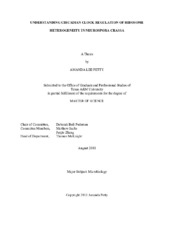| dc.description.abstract | The circadian clock is a conserved mechanism that allows organisms to coordinate their daily
physiology and behavior with 24-hour environmental cycles. The pervasiveness of the circadian
clock is evident in that roughly half of mRNAs in eukaryotes accumulate with a circadian
rhythm. The fungus, Neurospora crassa, has served as a model system to understand how the
circadian clock influences daily rhythms and gene expression. In addition to transcriptional
control of the circadian clock, there is evidence to support clock regulation of posttranscriptional,
translational, and post-translational control of gene expression. Previous studies
in the Bell-Pedersen lab demonstrated that the clock regulates the stress-associated p38 MAPK
pathway, which in turn, regulates the activity of translation elongation factor eEF2 in N. crassa.
In addition, our lab has discovered that the activity of eukaryotic initiation factor 2α (eIF2α) is
clock-controlled. Moreover, recent preliminary data from mass spectrometry suggested that the
clock controls the amount of ribosomal proteins associated with ribosomes, which in turn may
lead to rhythms in mRNA translation. This mass spectrometry data identified 15 ribosomal
proteins and their variants as candidates to examine for rhythmicity. In this study, I test the idea
that the composition of the ribosome changes throughout the day. First, I generated homokaryons
of V5-tagged ribosomal proteins, RPL27 and RPS19, indicating that the tagged proteins maintain
some level of function. Next, I showed that RPL27-V5 and RPS19-V5 abundance in pelleted
ribosomes was not rhythmic. Finally, I discovered that the cellular ratio of ribosomal components
showed no obvious time of day difference in two timepoints (DD12 and DD24). Similar analyses
of ribosomal component ratios in RPL25-FLAG and RPL27-V5; RPL25-FLAG strains suggested
that these epitope tags may partially interfere with ribosome activity. Despite these challenges,
there are thirteen additional ribosomal proteins remaining to be independently validated for
rhythmicity, and while this method shows promise, caution must be taken when using tags on the
ribosomal proteins. Therefore, futures studies will be performed with an alternative tagging
method or using ribosomal protein antibodies to monitor rhythms in the endogenous ribosomal
proteins. | en |


